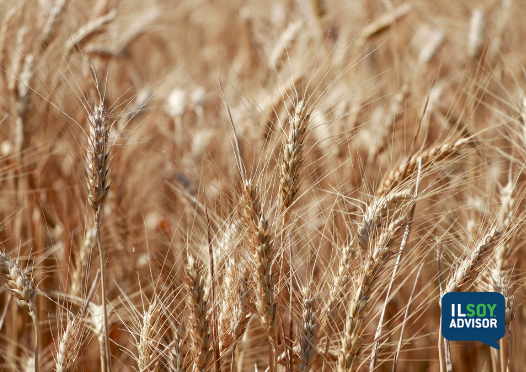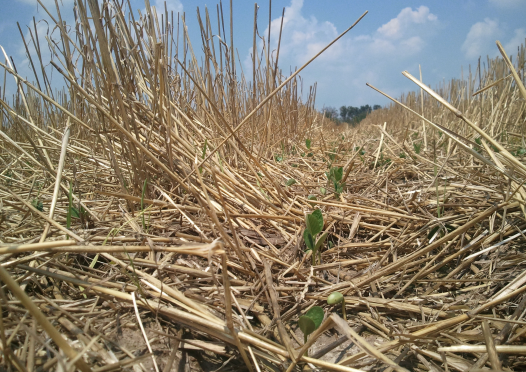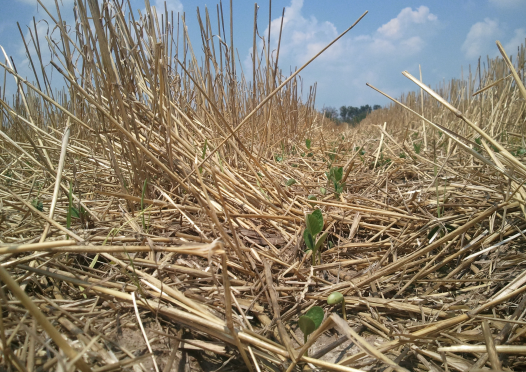ILSOYADVISOR POST
Agronomy: Lodged Wheat: The Double-Crop Nightmare
To say that Southern Illinois has been blessed with rain this spring is an understatement. Here at our farm we have had over 9 inches of rain from April 1 until June 10. And that rain has also come with some storms. Those storms along with a fast-growing wheat crop and late-season nitrogen applications have come combined to give us something we don’t want—lodging.
Lodging is a term used to describe wheat that has fallen down flat or has leaned over and rests against the plants next to it. Those plants resting against each other have a domino effect. There are a number of reasons for lodging, the most common being an excessively dense canopy of lush growth, often caused by excessive nitrogen rates. Mix in some heavy rains and high winds and the canopy cannot support itself and the plants fall flat on the ground.
A little lodging is not a bad thing. We agronomist use lodging to “score” how close we came on our nitrogen rates. No lodging, then you didn’t get enough N on. A score of 10% – 15% lodging and you hit the sweet spot on N. More than 15% and you over-applied N. But that assumes that nitrogen is the only cause of the lodging.
In some areas where we had storms after grain fill started we have large sections of fields that have been blown flat. To quote one individual: “It looks like someone took a roller and rolled half of this flat.” There are spots, some very large in fields in certain areas where these storms occurred, that are practically lying flat on the ground.
Aside from the harvest consideration of picking this wheat up with the combine we have another concern; how to plant double-crop beans into this matt of material. In many cases the stems of these plants are still quite green, and will be green when wheat harvest starts.
Here are a few tips to help get beans off to a good start when planting into lodged conditions.
- First, if at all possible, get the combine head close to the ground and cut the entire plant. Get as much of the plant cut and through the combine as possible. This will help eliminate most of the problem, however, if the wheat is flat it may be near impossible to do.
- Second, consider harvesting in one direction in lodged areas to help get the crop into the combine and also cut the material off.
- Third, limit wheat traffic as much as possible to avoid sticking the wheat to the soil.
- Fourth, make sure no-till cutters on the planter are sharp.
- Fifth, increase down pressure on the planter units and on the cutters to get through the residue.
- Sixth, ensure that closing wheel pressure is sufficient to close the seed slot under all that straw.
- Seventh, wait until late in the day to plant lodged fields. The drying action of the sun all day will help make the residue easier to cut with the planter.
- Eighth, try to plant with the direction of the lodging to help the planter comb its way through the straw.
I know I have asked a lot in these eight tips in the middle of a compressed spring. But having a plan now and working that plan will help to ensure a good stand of double-crop beans in lodged wheat.
Kelly is serving as the Illinois Soybean Association Double-Crop Specialist. He was raised on the family farm in Benton, Illinois and graduated from Southern Illinois University (SIU)-Carbondale with a BS in Agriculture Education and Mechanization, and a Master’s of Science (MS) in Plant and Soil Science. Kelly has spent 25 years as a soil fertility agronomist and precision agriculture consultant in southern Illinois while also spending 4 years as a Farm/Agronomy Manager and GIS Coordinator for a large farm in southeastern Illinois. He is a Certified Professional Agronomist and a Certified Crop Advisor.





Comments
Add new comment